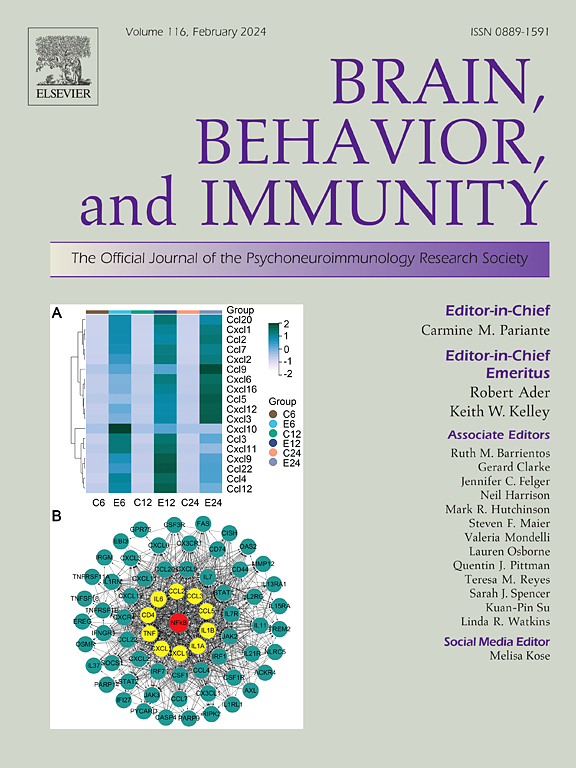Sex-specific spatial memory deficits associated with region-specific neuroinflammatory changes in the dorsal hippocampus of rats exposed to neonatal repeated maternal separation
IF 8.8
2区 医学
Q1 IMMUNOLOGY
引用次数: 0
Abstract
The hippocampus is an essential brain structure for memory and emotional regulation and is particularly vulnerable to early life stress, which disrupts its development and increases the risk of neuropsychiatric disorders. Using the neonatal maternal separation model of early life stress, we explored sex-specific behavioral and molecular alterations, focusing on hippocampal function, neuroinflammation, and associated signaling pathways.
Our results show that neonatal maternal separation induces mechanical and thermal hypersensitivity, as well as anxiety-like behaviors in both male and female rats, but spatial memory deficits were observed exclusively in males. These male-specific cognitive impairments are associated with a pro-inflammatory response in the dorsal CA1 subregion of the hippocampus. Molecular analyses also showed sex- and region-specific changes in oxytocinergic signaling and chloride cotransporters, suggesting plastic mechanisms affecting local neuronal inhibition.
These findings highlight the pronounced sex differences in hippocampal vulnerability to early adversity, with males displaying an intense neuroinflammatory signature in dorsal CA1 associated with spatial memory deficits. This work highlights that the cognitive component of pain needs to be studied more systematically to better understand sex differences that are not necessarily easy to observe in the sensory and emotional components.
新生儿反复分离大鼠的性别特异性空间记忆缺陷与海马背侧区域特异性神经炎症变化相关
海马体是记忆和情绪调节的重要大脑结构,特别容易受到早期生活压力的影响,这会破坏海马体的发育,增加神经精神疾病的风险。利用新生儿母亲分离早期生活压力模型,我们探讨了性别特异性行为和分子改变,重点关注海马功能、神经炎症和相关信号通路。我们的研究结果表明,新生儿母亲分离诱导雄性和雌性大鼠的机械和热过敏以及焦虑样行为,但空间记忆缺陷仅在雄性中观察到。这些男性特有的认知障碍与海马背侧CA1亚区的促炎反应有关。分子分析还显示,催产素能信号和氯共转运体的性别和区域特异性变化,表明影响局部神经元抑制的可塑性机制。这些发现强调了海马对早期逆境的易感性的显著性别差异,男性在与空间记忆缺陷相关的CA1背侧显示出强烈的神经炎症特征。这项工作强调,需要对疼痛的认知成分进行更系统的研究,以更好地理解在感觉和情感成分中不一定容易观察到的性别差异。
本文章由计算机程序翻译,如有差异,请以英文原文为准。
求助全文
约1分钟内获得全文
求助全文
来源期刊
CiteScore
29.60
自引率
2.00%
发文量
290
审稿时长
28 days
期刊介绍:
Established in 1987, Brain, Behavior, and Immunity proudly serves as the official journal of the Psychoneuroimmunology Research Society (PNIRS). This pioneering journal is dedicated to publishing peer-reviewed basic, experimental, and clinical studies that explore the intricate interactions among behavioral, neural, endocrine, and immune systems in both humans and animals.
As an international and interdisciplinary platform, Brain, Behavior, and Immunity focuses on original research spanning neuroscience, immunology, integrative physiology, behavioral biology, psychiatry, psychology, and clinical medicine. The journal is inclusive of research conducted at various levels, including molecular, cellular, social, and whole organism perspectives. With a commitment to efficiency, the journal facilitates online submission and review, ensuring timely publication of experimental results. Manuscripts typically undergo peer review and are returned to authors within 30 days of submission. It's worth noting that Brain, Behavior, and Immunity, published eight times a year, does not impose submission fees or page charges, fostering an open and accessible platform for scientific discourse.

 求助内容:
求助内容: 应助结果提醒方式:
应助结果提醒方式:


